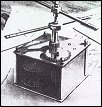The Naming of the Helicopter

|
Few machines have had as many different names as the helicopter. Leonardo da Vinci, in writing of his proposal for a flying machine, called it only an "instrument" and a "screw," but in the second half of the eighteenth century, with a revival of interest in the idea of airscrew flight, a whole new family of words were created.
In 1754 the Russian scientist Lomonosov demonstrated a spring-driven model helicopter; in the English translation the name of this little machine reads "Aerodynamic." Fourteen years later (1768) a French mathematician, J. P. Paucton, described a man-powered helicopter which he called a "Pterophore." Another French name for an airscrew machine that appeared later in the eighteenth century (1784) was "Automoteur."
Still more words of French origin followed, indicating the steady interest in the subject in that country. "Automate" was coined in 1816 and "Aeroveliero" in 1823, but neither was widely accepted. Two words did catch on during the first half of the nineteenth century in France and were used to describe the popular toy helicopters, variations on the ancient Chinese top: "Spiralifere" and "Stropheor." The Spiralifere was a tiny rotor made of cardboard; when spun with a string it could rise a few yards into the air. The Stropheor was a more rugged version of the same toy; one contemporary writer said it was "much smaller and heavier [than the Spiralifere] and has sharp metal blades dangerous to passerby and attains the height of the most elevated belfries..." In one form or another, the Stropheor was used by many of the nineteenth-century researchers to determine elementary rotor data. With only the short hops of this simple device as a basis, many overly enthusiastic experimenters predicted unbelievable performance for their full-scale designs. On the whole, less imagination in creating new names was shown by the English-speaking inventors of the day; perhaps the language was less suited for concocting new and colorful variations. Sir George Cayley, simply called his rotating-wing aircraft "aerial carriage" or "aerial vehicle" (1843). In the United States, the magazine Scientific American described, in 1848, what seems to have been the first recorded design for a helicopter in this country — without giving any sort of name at all. The rotors, however, were called "wheel wings", a not inappropriate description. Another phrase used by an American inventor in 1869 was "aerial car" — a catch-all phrase comparable to "flying machine" and probably the least inspired of the lot.
Eventually, the French enthusiasm for creating new names paid off handsomely. In 1863 or thereabouts the Viscomte de Ponton d'Amecourt arrived at the name we use today. A dedicated advocate of rotating-wing flight, the viscount acted in company with other like-minded Parisians to speed its development, and he accomplished as much as could be done, considering the technology of his day (a 4-pound steam-driven coaxial model of his design is in the French Air Museum). His new word, based on the Greek "helicos" meaning helix and "pteron" meaning wing, was "Helicoptere." It soon caught on and was accepted in England and the United States as well, though in the English form the last "e" was dropped. During the last half of the nineteenth century the word was often used with the limited meaning of "rotor" alone, for example as in "the flying machine was designed to be lifted by four helicopters." This is not surprising; after all, the only helicopters then flying were the tiny toy rotors made after the fashion of the Chinese top. Nevertheless, the word was safely installed in the dictionary, and when the first man-carrying helicopters appeared, after the turn of the new century, it was ready and waiting—one of the few cases in history where the name for a new machine existed before the fully developed invention itself. Some inventors, naturally enough, were not eager to surrender the right to name their new creations, and any number of new words blossomed forth. The dean of the European inventors, Louis Breguet, who test-hopped a four-rotor machine at Douai, France, in 1907 and then went on to build the first really successful European helicopter in 1935, insisted on the name "Gyroplane." This caused some confusion, since "Gyroplane" in the period before World War II was used regularly for still another form of rotating-wing aircraft, special types of the autogiro. Other names that appear in the record include "Aeromobile," "Autovol," and "Cyrnottero" — all dating from 1908, "Gyrocopter" (1910), "Gyroptere" (1915), "Alerion" (1919), "Helicogyre" (1920's), "Helicon" (1924), "Aerocar" (1931), and what was perhaps the prize of them all, the "Heliogyrocopter," also of 1931. C.Gablehouse "Helicopters and Autogiros", 1969 |



